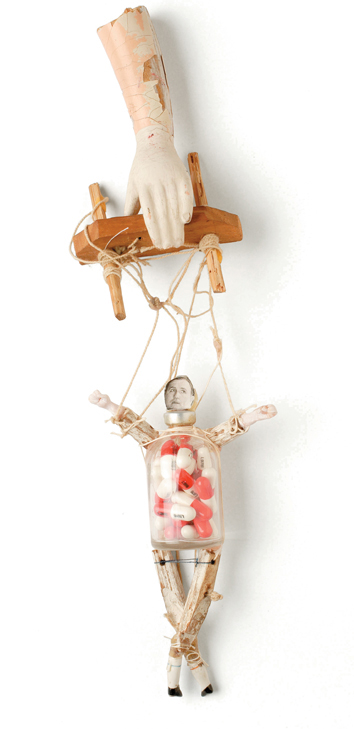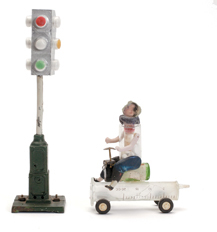Will the FDA satisfy its critics?
Polly Becker |
|
 |
|
Sidebar: Becoming a drug
By MICHELLE L. BRANDT
BeatrÍz Bravo knows how it feels to be the Tinman in the land of Oz. Bravo, who has suffered from rheumatoid arthritis since 1985, struggles as she makes even the slightest moves during her effort to get out of bed each morning. “It takes 15 to 30 minutes before I can move without feeling pain in every part of my body,” says Bravo, a Stanford Cancer Center medical oncology social worker. “I’m like the Tinman who hasn’t been oiled.”
Without her painkillers — including Celebrex and three others for her arthritis — Bravo believes it would be difficult to get out of bed and to work. So when she heard recent reports that Celebrex and other Cox-2 inhibitors have severe side effects, it struck hard.
“The fact that I’m taking it is stressing me out,” says Bravo, who decided to continue the drug after her doctor cautioned her of potential side effects. “I hope to God that I don’t have a heart attack or stroke but my other alternative is to be in constant pain.”
Bravo isn’t the only one who’s troubled over drug safety. Millions of Americans also dependent on medications began opening their medicine cabinets with a sense of dread this fall after several other well-known drugs, including another pain reliever, Vioxx, appeared on the hit list.
For years, some patient advocates and lawmakers have publicly questioned the efficacy of the FDA, the agency charged with approving and monitor-ing medications. But public concern rocketed when a top FDA insider blew the whistle. David Graham, MD, an associate director of drug safety, told Congress this fall what many outside critics have been saying for years: Americans are “virtually defenseless” against unsafe drugs.
To describe the agency’s failures, critics began using phrases more commonly attached to Hollywood’s latest flop than to the inner workings of a federal agency. Sen. Edward Kennedy (D-Mass.), ranking Democrat on the Senate Health, Education, Labor and Pensions Committee, called the agency’s drug-safety record a “catastrophic failure” during a committee hearing last November. In a Los Angeles Times article that same month, consumer advocate Sidney Wolfe of Public Citizen called the FDA’s internal reform effort “largely a farce.”
It’s easy to point fingers, but many experts agree that the real culprit isn’t the FDA itself. The problem is a severely underfunded and inadequate system for monitoring the safety of already-marketed drugs.
“The fact of the matter is that the Congress has never given FDA either the mandate or the appropriations to mount a successful monitoring system for drug adverse reaction epidemiology in this country,” Donald Kennedy, PhD, FDA commissioner from 1977-79 and former Stanford University president, told National Public Radio in December. “There’s no reason not to have one."
The approval process
Drugs make their way into the hands of Bravo and other Americans after being approved by the FDA’s Office of New Drugs. FDA regulators gave the thumbs-up to 953 new drug applications between 1993 and 2003. In the course of these reviews, they look at the results of clinical trials and weigh potential benefits against side effects.
Every drug has risks, and the severity of a particular ailment plays a big role in regulators’ decision to deem a drug safe. “Regulators and doctors tolerate greater uncertainty and more severe side effects for a potential cure for pancreatic cancer or AIDS, for example, than for treating age spots or indigestion,” explains Henry Miller, MD, an FDA official from 1979-94 who is now a fellow at Stanford’s Hoover Institution.
Although some argue that the approval process — which now averages about 13 months — is too fast, Donald Kennedy disagrees. He believes the FDA is “pretty near the right place” when balancing safety issues with public demand for new therapies.
Polly Becker |
|
 |
|
Far more worrisome is the flimsy system for monitoring drugs once they’re on the market. Ask almost any expert and you’ll hear the same thing: the office in charge of this important task — the FDA’s Office of Drug Safety — lacks an effective, systematic approach to tracking a drug’s usage, monitoring adverse reactions and taking action when serious safety issues arise.
To track adverse effects, the FDA relies primarily on voluntary reports to its MedWatch system from drug companies and physicians. But the reporting is spotty: drug companies have a financial incentive not to report negative things about their products, and physicians are often too busy to comply. “If physicians report side effects, they have to fill out lots of paperwork — which is a disincentive,” says Miller.
Catherine DeAngelis, MD, editor-in-chief of the Journal of the American Medical Association, calls the set-up a “passive system of voluntary reporting” that prevents the FDA from detecting serious adverse drug events. Indeed, studies have shown that only 10 percent of adverse effects are actually reported through MedWatch.
A second way the FDA can learn about safety concerns is through “post-market” studies. The new drugs office often requires that companies conduct these studies as a condition of drug approval, but an FDA report submitted to Congress last March showed that two-thirds of drug companies hadn’t performed the studies they promised.
Another concern is that the safety office lacks clear authority to take action when safety issues arise. Regulators there can make recommendations, such as suggesting that a company print a warning label on a product, but they cannot enforce their recommendations.
Some critics are troubled that the FDA is involved in the monitoring process at all since it places the agency in the contradictory roles of approving new drugs and then possibly turning against them. DeAngelis and others say this set-up creates an awkward situation, as regulators might be reluctant to contradict a decision they or their colleagues have made.
“If you want accountability, it doesn’t makes sense to have the office that reviews the safety of drugs to be under the thumb of the office that puts the drugs on the market in the first place,” U.S. Sen. Charles Grassley (R-Iowa), who has been a vocal critic of the FDA, commented during a spring press conference.
Complicating matters is the fact that no drug is absolutely safe. “People assume FDA approval is the final answer,” says Randall Stafford, MD, PhD, an associate professor of medicine at Stanford who has published numerous papers on drug prescribing. Approval, he adds, is really just the agency’s best guess — based on existing evidence — about a drug’s safety and effectiveness.
Drugs go through several rounds of clinical trials before they’re approved, but those trials usually include hundreds or thousands of people — an insignificant number compared with the millions who potentially will take the drug once it’s on the market. Most trials are just too small to uncover all negative side effects.
Cause for alarm
Polly Becker |
|
 |
|
The fact that drugs aren’t always safe became clear this fall, when the maker of the popular painkiller Vioxx pulled the drug from the market because of safety issues. The public learned that the manufacturer, Merck, had known for years that the drug increased risk of heart attack, and it informed the FDA of the risk in 1999. The FDA negotiated with the company to include a warning on the drug’s label, and the first warning was included in 2002. Merck voluntarily pulled the drug last year after more research linked the drug with heart attacks and stroke. Then in May, the company’s chief executive, Raymond Gilmartin, resigned on the same day congressional investigators released documents detailing how the company promoted Vioxx aggressively after it knew of potentially serious safety concerns.
Back in March, Sen. Kennedy called the gap between the time the FDA learned of the risk and the time it took action “disgraceful.” Patient advocates agreed. “The failure of the FDA to be more vigorous in pursuing questions when they arise has resulted in unnecessary suffering for people,” says Rob Schneider, campaign director for www.PrescriptionForChange.org, a Consumers Union lobbying group.
In April, the FDA announced it was pulling another Cox-2 selective painkiller, Bextra, from the market and requiring a strict warning label for Celebrex, the drug Stanford medical social worker Bravo has been taking.
But this did little to quiet critics’ concerns. Many were alarmed by earlier, ominous congressional testimony from FDA employee Graham, who questioned the safety of other drugs on the market. And some were still troubled that the FDA had waited too long to order manufacturers to place warnings on certain antidepressants, taking action only after a federal panel’s 2004 report indicated that antidepressants could cause children and teenagers to become suicidal.
This past winter, the media went wild over a collection of FDA failures. And critics, including numerous members of Congress and JAMA’s DeAngelis, began calling for an overhaul of the FDA. The agency, once considered a model for assuring drug safety, was now in a full-fledged battle for legitimacy.
A muscle with no power?
Although the FDA isn’t blameless, some observers believe the agency isn’t as villainous as it has been portrayed. Donald Kennedy, the former FDA head, is one of many to maintain that the agency has done a good job over the years and might continue to do so.
“It can monitor safety perfectly well if the mandate and resources are there,” he says.
Despite the bad press the agency has received, the public appears to agree with Kennedy. In a Gallup poll conducted after Congressional hearings about Vioxx concluded, 70 percent of people said they still had a great deal or moderate amount of confidence in the FDA’s ability to ensure prescription drugs are safe. “The public sees it as an agency that is serious about science and one that is there to protect them,” Kennedy explains.
The agency’s Achilles heel — and a big reason for the Vioxx debacle — is its lack of regulatory muscle. In the case of Vioxx, Sandra Kweder, deputy director of the Office of New Drugs, has said that the agency didn’t have enough leverage to force Merck to include a warning label when it first learned of Vioxx’ safety concerns. As dictated by the process, it instead had to work with Merck until both parties agreed on a solution — a process that took months.
FDA regulators have the ability to yank drugs from the market, but the process is difficult and it can take months or years of legal wrangling to do so. Bureaucratic maneuvering is just one problem. Sufficient staffing is another. Only 110 people work in the safety office — which boils down to one drug safety monitor for every 31 million prescriptions filled in the United States.
Aside from big-time problems with the monitoring process, much of the FDA’s recent problems arise from the conundrum that many drugs with great healing potential are themselves inherently risky. Critics tend to make the FDA the scapegoat for this almost existential dilemma.
“I think there’s a sense that people expect zero risk, but anyone who has gone through a course of chemotherapy knows that some drugs are hugely toxic,” says Kennedy.
Get it right
There is still much room for improvement in the FDA, and lawmakers and scientific leaders have proposed reforms to the drug monitoring system. The FDA offered its own solution in February, when it said it was creating a new safety board to monitor drugs for unexpected side effects. Still in the planning stage, the board will consist of FDA and other government officials and will make recommendations to the agency if any action is needed.
Yet the FDA’s announcement failed to appease many critics. In April, Sens. Grassley and Christopher Dodd (D-Conn.) went ahead and introduced another plan, a bipartisan reform bill establishing an independent drug safety office within the FDA. The office would be given explicit authority to require labeling changes and pull advertising while safety studies are completed.
Months before this legislation was introduced, JAMA’s DeAngelis expressed support for an independent agency. “This agency should be given full authority to… establish an effective national active surveillance system with a prospective, comprehensive, and systematic approach for monitoring, collecting, analyzing and reporting data on adverse events,” she wrote in a December editorial in that journal. She also recommended that the safety office mandate that companies conduct post-market studies and report this follow-up information.
Along those same lines, Grassley and Dodd recently introduced legislation that would require companies to publish all their clinical data (both pre- and post-market) — not just data that makes their products look good. Patient advocate Schneider believes having this information in the public domain would make it difficult for the FDA and drug companies to avoid discussion and evaluation of drug safety problems.
Some patients agree that companies should be included in drug reform. “I have absolutely no faith whatsoever that companies are providing the FDA with accurate information,” says Bravo, the arthritis patient.
As expected, the pharmaceutical industry is calling for a tempered approach. “By and large the FDA’s system works,” says Jeff Trewhitt, spokesman for the Pharmaceutical Research and Manufacturers of America.
At the FDA’s request, the Institute of Medicine is investigating the drug safety system at the FDA and suggesting changes. “We certainly have time to wait and see what those recommendations are,” says Trewhitt.
Donald Kennedy, in the meantime, believes the focus should be on equipping the FDA with resources and authority — to ensure it can better detect and respond to problems. He recommends that the agency establish a systematic approach for monitoring, collecting, analyzing and reporting data on adverse events. Kaiser Permanente’s extensive patient record database — which the insurance company used to uncover problems with Vioxx well before the drug was removed from market — could be used as a model, he says.
In an ideal world, says Kennedy, policymakers would pay attention to the entire system of health care — of which the FDA and drug companies are a part. The system is broken and unsustainable, he says. If it were fixed, “then we wouldn’t have these arguments about pieces of the enterprise,” he adds.
While major health-care reform might be years away, significant change to the FDA could come this year. Drug safety affects all of us, and Bravo and millions of others Americans would be well served if the Congress does in fact make a move — and does so quickly.
Comments? Contact Stanford Medicine at

